Mahoning Avenue is alive.
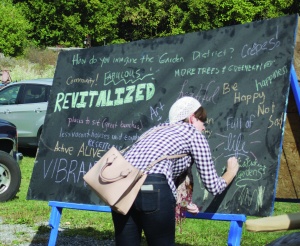
A woman at the Mahoning Avenue Better Block event chalks her vision for a revitalized Garden District Neighborhood.
Crowds line sidewalks adorned with benches and greenery. Children skateboard along freshly painted bike lanes. People gather around pop-up shops and file in and out of abandoned storefronts, repurposed as art galleries. The sounds of a string quartet and a few guitarists reverberate down the street.
It represents a vision of the past, when Mahoning Avenue was a vital commercial corridor, and a brief glimpse into a brighter future.
“That’s the core concept of Better Block — a demonstration of what’s possible,” Ian Beniston, executive director of Youngstown Neighborhood Development Corporation, said.
YNDC organized Saturday’s Mahoning Avenue Better Block and has two more on its slate this fall. Better Blocks are grassroots events intent on helping citizens recognize the potential of vibrant, walkable and mixed-use neighborhood centers.
“If longer term efforts were to take hold, this is what’s possible,” Beniston said.
He said part of Better Blocks is just getting people out on the street and showing that if you can create a critical mass, good things will happen.
Last year, YNDC started a farmer’s market in the Idora neighborhood. Beniston said it provides the neighborhood with healthy food access, but it also gets people engaging with the community in a productive way.
“It’s almost like what’s happening downtown,” Beniston said. “People are attracted there just because there are people out on the street going from place to place, and you see that in other cities too.”
BEGINNING TO SEE THE BLIGHT
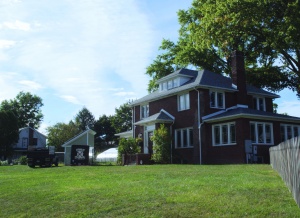
The campus of the Youngstown Neighborhood Development Corporation on Canfield Road in the Idora neighborhood.
YNDC’s offices occupy an old farmhouse on Canfield Road in the Idora neighborhood — just off Glenwood Avenue and a short walk from Lanterman’s Mill. Greenhouses surrounding the offices comprise Iron Roots Urban Farm. The iconic Revitalize van sits out front urging passersby to stand up and fight blight.
Beniston has worked for YNDC since its formation in 2009, first as its deputy director and now, for just over a year, as executive director.
Their work began in Idora. Beniston said they noticed that people were buying houses on the West Side of Mill Creek Park as soon as they went on sale, but that wasn’t happening on the East Side along Glenwood. So YNDC went to work with the goal of stabilizing the housing stock, focused on acquiring and rehabilitating some vacant homes, demolishing others and boarding up the rest.
“What we’re doing here isn’t something that’s groundbreaking,” Beniston said. “It’s not something that’s not been done here and in other places.”
The difference between what YNDC is doing and previous stabilization efforts is the scale of their work.
“Historically, the city’s boarded up a couple dozen homes per year. We’ve boarded up 600 in the past 12 months. Same thing with the grass cutting,” Beniston said. “It’s basic stuff.”
Now YNDC operates in all seven wards of the city. They’ve demolished more than 150 homes in partnership with the city and the Mahoning County Land Bank. They’ve rehabbed more than 200 blighted houses and boarded up more than 750 more. They’ve repurposed more than 300 vacant lots and cleaned up and cut grass at more than 3,000 others.
They’ve developed several neighborhood action plans with neighborhood action teams in place to assist with implementation. They’ve targeted neighborhoods like Brownlee Woods, Crandall Park and the Garden District — where last weekend’s Better Block was held.
Beniston said they employ a series of 10 metrics to identify constrained or transitional neighborhoods, things like tax delinquency and crime rates.
“In simple terms, those are tipping point neighborhoods, where if there’s not some intervention — and intervention that’s effective — those neighborhoods are going to become distressed,” Beniston said. “If we’re going to fix 50 houses, why not focus on a couple streets that would be most beneficial to these neighborhoods.”
The focused efforts lead to tangible results. If you drive through the Idora neighborhood today, it looks significantly different than it did five years ago.
DEFENDING YOUNGSTOWN NEIGHBORHOOD DEVELOPMENT CORPORATION
One could claim that boarding up houses and mowing lawns is primarily cosmetic, but there is research that shows these strategies are effective.
“You can start cold calling economic development directors in the Midwest,” Beniston said. “The first thing that they’re going to tell you is you’re never going to get any investment in your city if it looks bad. So you need to clean it up.”
Youngstown Mayor John McNally said YNDC has been instrumental in the city’s beautification efforts.
“They are really the main force in helping to improve quality-of-life issues in the city of Youngstown,” McNally said. “The city dollars and city staff cannot do everything. We need additional resources, and YNDC, quite frankly, has become that additional resource.”
They also address the perception that the city is unsafe. This needs to be overcome in order for people to feel comfortable buying houses and establishing businesses here.
“For a lot of people, if they drive down the street and there’s five houses with no doors or windows on them, or there’s a commercial building that’s crumbling and falling over. Whether that community is safe or not, that alone creates a perception that it’s not,” Beniston said.
Beniston said the city can attract jobs through economic development, but if people continue to move out of the city, those employment gains will be offset.
“We need to retain the people that are here — particularly people that are working — because if they don’t work in the city, and then they move out of the city, they are no longer paying city income tax,” Beniston said.
Their work hasn’t created thousands of jobs, but it has decreased vacancy rates in targeted neighborhoods, increased home ownership and stabilized property values.
They’ve also engaged the community. Last year alone, 1,000 residents and volunteers participated in neighborhood improvement projects. This year they’re expecting to increase that number by 50 percent.
GOING COMMERCIAL
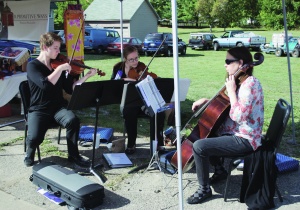
A string trio performs at the Mahoning Avenue Better Block on Saturday.
The natural progression of YNDC’s efforts to stabilize the neighborhood housing stock is the development of commercial corridors, which provide neighborhood residents with amenities and jobs.
“Often times, no matter how stable or marketable the actual interior residential streets are, if the commercial corridor’s not something that’s desirable, it’s very difficult to maintain stability within the surrounding neighborhood,” Beniston said.
Beniston said the lion’s share of their work is still residential, but they’re carrying out the same process of planning and removing blight along corridors — they’ve already removed dozens of buildings along Glenwood and they’re continuing to remove more. They’re also obtaining infrastructure grants and assembling land.
One of the challenges Youngstown faces as it looks toward revitalizing its commercial corridors is that the built environment isn’t as strong as it is in cities like Pittsburgh and Cleveland. Along Glenwood Avenue, there are swaths of vacant land between houses and commercial buildings.
“We don’t have density which means we don’t have walkability,” Beniston said. “So it’s a whole ‘nother challenge.”
The city has more commercial space than could be occupied given its current population, so finding alternative uses is a challenge as well.
“Some of it’s just going to be grass or perhaps spaces that can be temporarily activated, but not all the time.” Beniston said. “But in the interim, they can be maintained and look decent.”
They’ve focused the Better Blocks on areas that have some degree of density. He said that if there are four or five contiguous buildings that can be occupied, it creates a nucleus for future growth along that corridor.
The Better Block events function as a first step in the process of revitalizing corridors — temporarily activating the spaces — but it’s a long-term goal.
“It’s been decades in the making of disinvestment, buildings falling into disrepair, businesses leaving,” Beniston said. “The process of trying to get things back to a point where the blight is removed, the spaces in between are maintained and being used as active spaces, and then attracting business investment is a long one.”
To view the full coverage, click here.
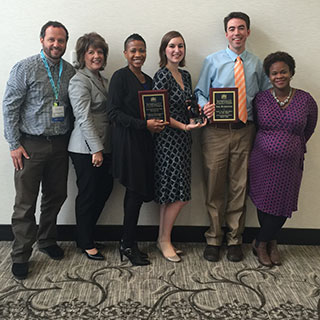 ,
, 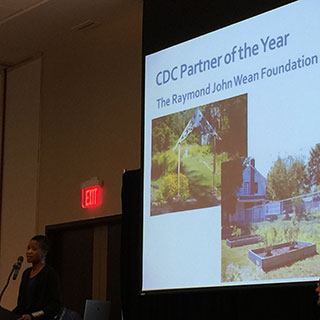 ,
, 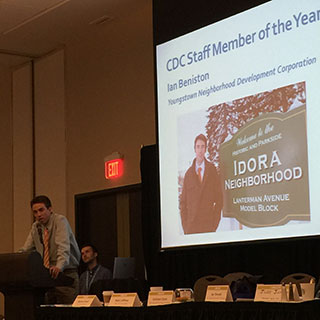 ,
, 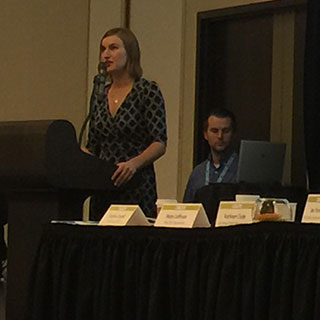
 ,
,  ,
,  ,
, 



